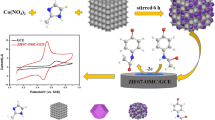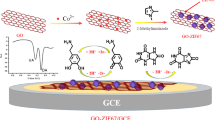Abstract
Due to the highly porous structure, metal organic framework (MOF)-derived materials are extensively applied in the field of electroanalysis. In this experiment, an effective electrochemical sensing based on Co3O4/C-derived ZIF-67 MOF had been constructed for ultrasensitive determination of quercetin at trace level. The resultant Co3O4/C porous polyhedron of morphology and nanostructure were carefully examined using transmission electron microscopy (TEM), scanning electron microscopy (SEM), X-ray powder diffraction (XRD), X-ray photoelectron spectroscopy (XPS), and Brunauer–Emmett–Teller (BET) techniques. Differential pulse anodic stripping voltammetry (DPV) method was adopted to analyze quercetin under the optimized conditions. The DPV response of Co3O4/C film-coated glass carbon electrode (Co3O4/C/GCE) for quercetin determination was achieved a long linearity ranging from 0.5 to 30 µM, achieving high sensitivity about 1.830 × 10− 6 A cm− 2 µM− 1, and the detection limit was calculated to be 0.022 µM (S/N = 3). Besides, the fabricated Co3O4/C/GCE displayed excellent selectivity, desirable repeatability, and good reproducibility. More importantly, the proposed sensor exhibited satisfactory recovery ranges and accuracy for the determination of trace quercetin in human urine and serum samples, which will make it as an alternative advantageous choice for practical on-site determination.
Graphical abstract
The porous Co3O4/C polyhedron derived by ZIF-67 MOF was successfully synthesized. The as-synthesized material was employed to prepare chemically modified electrode for ultrasensitive determination of quercetin. Then the Co3O4/C-modified glass carbon electrode is displayed good sensitivity and accuracy toward quercetin in urine and serum samples.











Similar content being viewed by others
References
Nghia NN, Huy BT, Lee YI (2020) Highly sensitive and selective optosensing of quercetin based on novel complexation with yttrium ions. Analyst 145:3376–3384
Chen Y, Huang W, Chen K, Zhang T, Wang Y, Wang J (2019) Facile fabrication of electrochemical sensor based on novel core-shell PPy@ZIF-8 structures: enhanced charge collection for quercetin in human plasma samples. Sens Actuators B 290:434–442
Saritha D, Koirala AR, Venu M, Reddy GD, Reddy AVB, Sitaram B, Madhavi G, Aruna K (2019) A simple, highly sensitive and stable electrochemical sensor for the detection of quercetin in solution, onion and honey buckwheat using zinc oxide supported on carbon nanosheet (ZnO/CNS/MCPE) modified carbon paste electrode. Electrochim Acta 313:523–531
Luo G, Deng Y, Zhu L, Liu J, Zhang B, Zhang Y, Sun W, Li G (2020) Au-Co nanoparticles-embedded N-doped carbon nanotube hollow polyhedron modified electrode for electrochemical determination of quercetin. Mikrochim Acta 187:546
Durai L, Kong CY, Badhulika S (2020) One-step solvothermal synthesis of nanoflake-nanorod WS2 hybrid for non-enzymatic detection of uric acid and quercetin in blood serum. Mater Sci Eng C Mater Biol Appl 107:110217
Liu Y, Xie R, Yang P, Lu L, Shen L, Tao J, Liu Z, Zhao P (2020) An excellent electrochemical sensor based on highly porous gold film modified gold electrode for detecting quercetin in food and medicine. J Electrochem Soc 167:047514
Rahimi M, Bahar S, Heydari R, Amininasab SM (2019) Determination of quercetin using a molecularly imprinted polymer as solid-phase microextraction sorbent and high-performance liquid chromatography. Microchem J 148:433–441
Soylak M, Ozdemir B, Yilmaz E (2020) An environmentally friendly and novel amine-based liquid phase microextraction of quercetin in food samples prior to its determination by UV-vis spectrophotometry. Spectro Acta Part A, Mol Biomol Spectr 243:118806
Memon AF, Solangi AR, Memon SQ, Mallah A, Memon N, Memon AA (2016) Simultaneous determination of quercetin, rutin, naringin, and naringenin in different fruits by capillary zone electrophoresis. Food Anal Methods 10:83–91
Xu L, Pan M, Fang G, Wang S (2019) Carbon dots embedded metal-organic framework@molecularly imprinted nanoparticles for highly sensitive and selective detection of quercetin. Sens Actuators B 286:321–327
Alam AU, Deen MJ (2020) Bisphenol aelectrochemical sensor using graphene oxide and beta-cyclodextrin-functionalized multi-walled carbon nanotubes. Anal Chem 92:5532–5539
Mettakoonpitak J, Volckens J, Henry CS (2020) Janus electrochemical paper-based analytical devices for metals detection in aerosol samples. Anal Chem 92:1439–1446
Tao H, Zhang S, Chen C (2018) A design of Wsn based locking system. Acta Info Malaysia 2:4–6
Gupta JK, Gupta SK (2019) A comparative study of crowd counting and profiling through visual and non-visual sensors. Acta Info Malaysia 3:4–6
Hwang JH, Islam MA, Choi H, Ko TJ, Rodriguez KL, Chung HS, Jung Y, Lee WH (2019) Improving electrochemical Pb2+ detection using a vertically aligned 2D MoS2 nanofilm. Anal Chem 91:11770–11777
Lakshmanakumar M, Nesakumar N, Kulandaisamy AJ, Rayappan JBB (2021) Principles and recent developments in optical and electrochemical sensing of dopamine: a comprehensive review. Measurement 183:109873
Saljooqi A, Shamspur T, Mostafavi A (2020) Fe3O4@SiO2-PANI-Au nanocomposite prepared for electrochemical determination of quercetin in food samples and biological fluids. Electroanalysis 3:1–8
Kuyumcu Savan E (2019) Square wave voltammetric (SWV) determination of quercetin in tea samples at a single-walled carbon nanotube (SWCNT) modified glassy carbon electrode (GCE). Anal Lett 53:858–872
Ibrahim M, Ibrahim H, Almandil NB, Sayed MA, Kawde AN (2020) A new hybrid nanocomposite electrode based on Au/CeO2-decorated functionalized glassy carbon microspheres for the voltammetric sensing of quercetin and its interaction with DNA. Anal methods: Adv methods Appl 12:2846–2857
Cao M, Chang Z, Tan J, Wang X, Zhang P, Lin S, Liu J, Li A (2022) Superoxide radical-mediated self-synthesized Au/MoO3-x hybrids with enhanced peroxidase-like activity and photothermal effect for anti-MRSA therapy. ACS Appl Mater Interfaces 14:13025–13037
Tajyani S, Babaei A (2018) A new sensing platform based on magnetic Fe3O4@NiO core/shell nanoparticles modified carbon paste electrode for simultaneous voltammetric determination of quercetin and tryptophan. J Electroanal Chem 808:50–58
Karakaya S, Kaya İ (2021) An electrochemical detection platform for selective and sensitive voltammetric determination of quercetin dosage in a food supplement by poly(9-(2-(pyren-1-yl)ethyl)-9 h-carbazole) coated indium tin oxide electrode. Polymer 212:123300
Zhao P, Ni M, Xu Y, Wang C, Chen C, Zhang X, Li C, Xie Y, Fei J (2019) A novel ultrasensitive electrochemical quercetin sensor based on MoS2-carbon nanotube@graphene oxide nanoribbons/HS-cyclodextrin/graphene quantum dots composite film. Sens Actuators B 299:126997
Qiu W, Tanaka H, Gao F, Wang Q, Huang M (2019) Synthesis of porous nanododecahedron Co3O4/C and its application for nonenzymatic electrochemical detection of nitrite. Adv Powder Technol 30:2083–2093
Cui W, Kang X, Zhang X, Zheng Z, Cui X (2019) Facile synthesis of porous cubic microstructure of Co3O4 from ZIF-67 pyrolysis and its Au doped structure for enhanced acetone gas-sensing. Phys E 113:165–171
Saeb E, Asadpour-Zeynali K (2022) A novel ZIF-8@ZIF-67/Au core-shell metal organic framework nanocomposite as a highly sensitive electrochemical sensor for nitrite determination. Electrochim Acta 417:140278
Hu Y, Zhang L, Zhao P, Wang C, Fei J, Xie Y (2022) Ultrasensitive luteolin electrochemical sensor based on zeolitic imidazolate frameworks-derived cobalt trioxide@nitrogen doped carbon nanotube/amino-functionalized graphene quantum dots composites modified glass carbon electrode. Sens Actuators B 351:130938
Jo Y-M, Kim T-H, Lee C-S, Lim K, Na CW, Abdel-Hady F, Wazzan AA, Lee J-H (2018) Metal-organic framework-derived hollow hierarchical Co3O4 nanocages with tunable size and morphology: ultrasensitive and highly selective detection of methylbenzenes. ACS Appl Mater Interfaces 10:8860–8868
Zhang C, Chu W, Jiang R, Li L, Yang Q, Cao Y, Yan J (2019) ZIF-67 derived hollow structured Co3O4 nanocatalysts: tunable synthetic strategy induced enhanced catalytic performance. Catal Lett 149:3058–3065
Bai L, Guan Z, Li S, Zhang S, Huang Q, Li Z (2021) Nest-like Co3O4 and PdO/Co3O4 synthesized via metal organic framework with cyclodextrin for catalytic removal of bisphenol A by persulfate. Sep Purif Technol 255:117718
Doan TLH, Kim J-Y, Lee J-H, Nguyen LHT, Dang YT, Bui K-BT, Pham ATT, Mirzaei A, Phan TB, Kim SS (2021) Preparation of n-ZnO/p-Co3O4 heterojunctions from zeolitic imidazolate frameworks (ZIF-8/ZIF-67) for sensing low ethanol concentrations. Sens Actuators B 348:130684
Devi RK, Muthusankar G, Chen S-M, Gopalakrishnan G (2021) In situ formation of Co3O4 nanoparticles embedded N-doped porous carbon nanocomposite: a robust material for electrocatalytic detection of anticancer drug flutamide and supercapacitor application. Microchim Acta 188:1–15
Bai L, Zhang J, He J, Zheng H, Yang Q (2021) ZnO-Co3O4/N-C cage derived from the hollow Zn/Co ZIF for enhanced degradation of bisphenol A with persulfate. Inorg Chem 60:13041–13050
Li H, Lu B, Zhang W, Cao F, Li H, Zhang C (2020) Assembly of GO nanosheets-coated zeolitic imidazolate framework-67 nanocubes via electrospinning and their derivatives for enhanced lithium-ion storage performance. Energy Technol 8:2000209
Lu Y, Hu J, Zeng Y, Zhu Y, Wang H, Lei X, Huang S, Guo L, Li L (2020) Electrochemical determination of rutin based on molecularly imprinted poly (ionic liquid) with ionic liquid-graphene as a sensitive element. Sens Actuators B 311:127911
Liu H, Hassan M, Bo X, Guo L (2019) Fumarate-based metal-organic framework/mesoporous carbon as a novel electrochemical sensor for the detection of gallic acid and luteolin. J Electroanal Chem 849:113378
Şenocak A, Khataee A, Demirbas E, Doustkhah E (2020) Ultrasensitive detection of rutin antioxidant through a magnetic micro-mesoporous graphitized carbon wrapped Co nanoarchitecture. Sens Actuators B 312:127939
Mohammadzadeh Jahani P, Akbari Javar H, Mahmoudi-Moghaddam H (2021) A new electrochemical sensor based on europium-doped NiO nanocomposite for detection of venlafaxine. Measurement 173:108616
Xie Y, Zhang T, Chen Y, Wang Y, Wang L (2020) Fabrication of core-shell magnetic covalent organic frameworks composites and their application for highly sensitive detection of luteolin. Talanta 213:120843
Apetrei IM, Apetrei C (2018) A modified nanostructured graphene-gold nanoparticle carbon screen-printed electrode for the sensitive voltammetric detection of rutin. Measurement 114:37–43
Acknowledgements
This work was supported by the State Key Laboratory for Chemistry and Molecular Engineering of Medicinal Resources (Guangxi Normal University) (CMEMR2019-B10) and Light of Bagui of Academic Research and Studies Program in 2021 (Gui Zu Tong Zi, Document No. 64 of 2021).
Author information
Authors and Affiliations
Corresponding author
Ethics declarations
Conflict of interest
There is no conflict of interest in this paper.
Additional information
Publisher’s Note
Springer Nature remains neutral with regard to jurisdictional claims in published maps and institutional affiliations.
Rights and permissions
About this article
Cite this article
Zhang, Y., Zhang, L., Gong, T. et al. Facile synthesis of Co3O4/C porous polyhedrons for voltammetric determination of quercetin in human serum and urine. J Appl Electrochem 52, 1607–1616 (2022). https://doi.org/10.1007/s10800-022-01731-9
Received:
Accepted:
Published:
Issue Date:
DOI: https://doi.org/10.1007/s10800-022-01731-9




